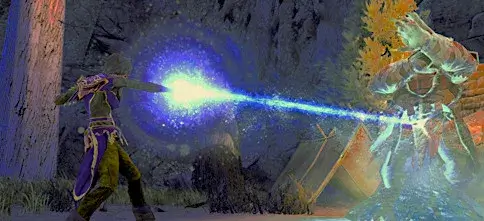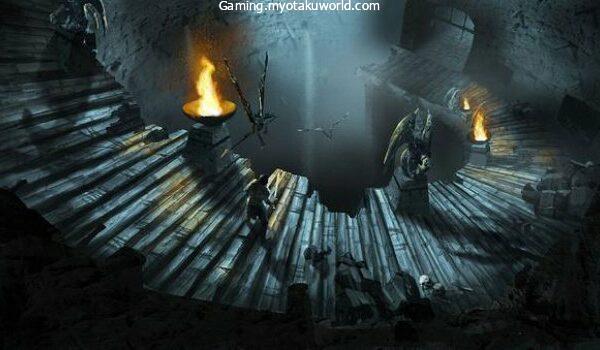There are many fire and fire-related spells available in D&D 5e including flame balls the sacred flame and the faerie fire.
However, most players ignore the other damage types that can be found in the game. Cold and frost damage is two of these types, which the ice spells are often overlooked.
Ray of Frost is one of the spells.
However, although it’s not so well-known as the spell that fireball is, it can do good damage and has several intriguing effects that every spellcaster should think about using in their toolbox.
Here’s our Ray of Frost 5e Guide to this spell.
What is the Ray of Frost?

The spell’s stats are according to the player’s manual:
- Evocation: cantrip
- The Casting time is 1 Action
- Range: 60 feet
- Components: V S
- Duration: Instantaneous
- Classes: Sorcerer, Wizard
A cold, white light slashes across an animal within a distance. Use a ranged spell on the person you want to target. When it’s hit, you will take 1d8 cold damage. its speed decreases by 10 feet up to the beginning of your next turn.
The damage of the spell increases by 1d8 as you progress to the 5th level (2d8) the 11th Level (3d8) or 17th degree (4d8)
Let’s take a look at the magic. It is an evocation spell that requires a somatic and vocal component. It can be utilized by wizards and sorcerers and can be used up to 60 feet. It requires only one action to cast, and you’ll have to cast a ranged attack.
If the spell’s attack is successful the target, take 1d8 cold injury and get their speed of movement slowed by 10 feet for the duration of your next turn.
When you progress to higher levels the damage will increase. It’s first of all, it’s a cantrip spell, which means you can utilize it for as long as you’d like, so long as you are ready to use it on the day. There is no requirement to destroy any slots for spells.
Then, and this is the most exciting part, there is no need to upgrade the spell. Instead of burning the second level slot to gain an additional D8 amount of damage all you need to do is to reach level five and the damage will go up by itself.
This is great for spellcasters since it provides you with extra damage to the spell as long as you are still using the spell. It means you can free the slots of your spells to use for other things.
It also has an impressive range of around 60 feet, and it is a spell that can be ranged. It either does or doesn’t, so you don’t have to worry about opponents taking a saving throw to avoid loss of damage or slowing down.
Then, let’s get to the fun part. When you hit the target the target’s speed of movement will be slowed by 10 feet until the beginning of the next round. To see how significant that can be the case, let’s talk about the movement of 5e.
A basic guide to movement in 5e
Most battle maps you play on whether in person or online are split into squares. The majority of them represent five feet of movement and your character can move at a speed equal to their movement which is approximately 30 feet (or 6 squares) per round.
A few characters wearing light armor or who are more graceful be able to move 40 feet in comparison to heavier characters and those with heavy armor will be slower, with the equivalent of 20 feet. There’s swimming, flying, and climbing speed, all of which have specific to their own rules.
Many enemies fall into the same range of movement in this case, and if you’re quicker than your adversaries, you may be able to close the distance between you and them or attempt to run. If you’re slower than your opponents, it is possible to beat someone else.
Speed control of the battlefield is something a strategically-minded player can benefit from, particularly using a cantrip such as Ray of Frost.
Using Ray of Frost on the Battlefield
Let’s say that your group is engaged in one of the classic D&D creature types: the humble wolf.
The wolf can move 40 feet of moving speed that is higher than most parties be able to achieve speed-wise. Also, Wolf packs are indeed common.
It can be extremely difficult to get away from a pack of wolves, even if you decide for a fight, the majority of animals employ hit and run strategies to attack you, run at speed at you, and make use of their other movements to get away.
This makes the fight more difficult as you are obliged to use your tactics to chase wolves and to bring them to melee range. Of course, they flee immediately afterward.
However, Ray Of Frost can be employed to not just cause damages to the wolf’s HP pool, but reduce their speed by a factor of 30 to 40.
The wolf’s speed is reduced to that of a normal player and then you’ll be able to defeat them with a straight battle.
They’ll be unable to run as quickly, and you’ll be able to get them in a place where they’ll be cut down.
Ray of Frost can also be utilized to help you out if you’re in a melee-focused situation.
If you’re a caster and you find yourself within melee range, you could attack your enemies with the Ray of Froz Spell, then move out from there, knowing that your adversaries are much slower and will be unable to get you until the beginning of their turn. This gives you and your allies time to respond.
The target’s speed is slowed to 10ft or two squares might not seem all to be all that exciting however once you’re on the battlefield map where every square counts You’ll start to enjoy the extra space!
Ray of Frost vs Frostbite

Two major themed cantrips are based on ice within the game. should you need to decide between the Frostbite cantrip or Ray of Frost spell, you must compare both. Below are the numbers for Frostbite, according to the manual for players:
- Evocation cantrip
- Time to Cast: 1 action
- Range: 60 feet
- Spell Lists: Druid, Sorcerer, Warlock, Wizard, Artificer
- Components: V, S
- Duration: Instantaneous
The cause of numbing is to appear on a creature that can be seen within a distance. The target has to make a Constitution saving roll.
If the save fails the target suffers 1d6 cold damages, and is at an advantage in the next attack roll that it makes before the close of the next turn.
At Higher Levels. The damage of the spell is increased by 1d6 as you reach the fifth level (2d6) the 11th degree (3d6) as well as 17th level (4d6).
We won’t cut the spell in the same way as we did with Ray of Frost, but in essence, it is cast, and the target has to make a Constitution saving roll.
If the save fails, 1d6 cold damage is dealt and the target is then at an advantage on the next attack because of the cold’s numbing effect. Similar to Ray of Frost, the damage dice increase when you increase your level.
Comparing the Two
The first is that first, the Ray of Frost does 1d8 cold damage, and also slows its speed on the target while the Frostbite spell does 1d6 cold damage and the target suffers a disadvantage.
Therefore, if you’re seeking something that can cause damage, the Ray of Frost has Frostbite defeated.
However, you must also consider the effects that both spells can have on their target. Although slowing down speed may be quite effective for larger areas, especially against speedier opponents.
Furthermore, you target the opponent using an attack that is ranged and they are either hit or avoid the spell.
If, however, you’ve got lots of dungeons and dungeons where a -10 decrease in speed isn’t that important or you’re fighting opponents who are already slower, then this isn’t the most effective spell to use.
Frostbite causes less damage, and it also requires the player to make a saving roll. Constitution is a fairly high score for the majority of monsters.
Unless you have a high effect DC and the creatures that you cast the spell on could be able to withstand the cold.
However, the additional disadvantage could be beneficial in times when you require some breathing space against stronger enemies.
In addition, regardless of how you react or when you’re in battle, you’ll always have to create disadvantages for your foes.
It’s always useful. It’s all you need to do is roll quite high to get off the opponent’s massive CON. If you can take advantage of the free advantage, it could alter the course of the game.
Ray Of Frost FAQs
Can Ray of Frost freeze water?
No. As written, Ray of Frost does not freeze things that are hit by it.
Can you stack Ray of Frost?
Ray of Frost’s slowing effect can’t be stacked. The second use of Ray of Frost will hurt the target, but it won’t slow them down.
Is it a Utility Spell?
The majority of players prefer using combat spells to fight however there’s always a couple who wish to utilize their spells for more than in combat. If you’re Ray of Frost player decides they’d like to play Bobby Drake’s Iceman. You can discuss the fact that it’s not a useful spell. Although some believe they can use the power of the Ray Frost can be powerful enough to freeze over lakes and provide reinforcement to doors, it’s not like that.
One strategy that certain DMs employ to show what spells can and should not accomplish is to consider liquid nitrogen. When you throw a vial of liquid nitrogen into an animal, it would become cold and experience negative consequences. If you were to throw the same vial into the water, you’ll be fortunate to pull an ice cube from the entire thing.
Also, it is important to discuss with your players to be aware that although Ray of Frost might slow down an enemy’s speed and keep them frozen, it’s not powerful enough to do much more, unless you use the spell several times. Even then, it’s an enormous amount of power and very few outcomes.
Is Ray of Frost a bonus action?
No, it doesn’t. Ray of Frost takes 1 action to cast.
Can you use Twinned Spell on Ray of Frost?
Yes. Ray of Frost is a spell that can only hit one person, so it can be used with the Sorcerer’s Twinned Spell.
How should we roleplay the Ray of Frost?
The spell needs an emotional and verbal element, you can take on the role of Elsa of Ice and blast those around you while singing. You can also create some cold puns and continue to freeze your opponents with both the ray as well as your horrible selection of phrases.
You could also target different parts of your opponent’s body. You can zap your wolf’s legs, and slow them down as they run. You can aim the ray into the club arm of a bugbear and then weigh it down, causing them to stumble. It is possible to even apply ice on dragon’s wings to provide them with extra weight.
It’s only a matter of roleplay and aesthetics However, you can still enjoy it, and also give yourself an explanation for why you’re slowing your adversaries down. In addition, it can allow your group to become more precise in combat also, which makes it more enjoyable in time’s end.
Should I build a Cryo-Focused character?
Elemental-themed characters are always enjoyable to play with, like themed characters that are based on certain beliefs or capabilities. If you take a look at cantrips dealing with the cold and ice it is possible to create a Cyro-caster, if you wish to.
There are many spells at all levels that focus on cold. Some of them comprise Absorb Elements, Ice Knife Cone Of Cold Ice Storm, and also potions for cold resistance as well as other items which reduce the cold. It’s fun creating a character with a theme and it’s easy to build a background story that is focused on the winter cold mountains, the snow, and the roaring wind. Cryo-focused spells are focused on damage, while also slowing down targets.
Of course, you’ll have to talk to your DM to taste some of the existing spells to help them concentrate on water and ice magic. Be sure to discuss things over and consider how you can make it happen however, the majority of DM’s will assist their players in creating an interestingly powered character. They can then connect the story to your theme, and add an extra dimension to the whole game.









